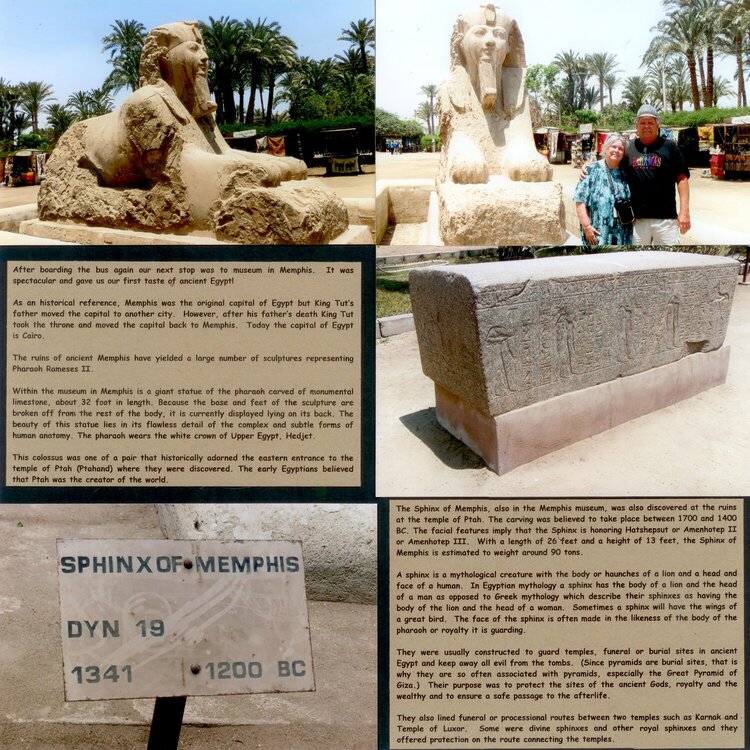

 Give a Cheer
Give a Cheer
After boarding the bus again our next stop was to museum in Memphis. It was spectacular and gave us our first taste of ancient Egypt!
As an historical reference, Memphis was the original capital of Egypt but King Tut's father moved the capital to another city. However, after his father's death King Tut took the throne and moved the capital back to Memphis. Today the capital of Egypt is Cairo.
The ruins of ancient Memphis have yielded a large number of sculptures representing Pharaoh Rameses II.
Within the museum in Memphis is a giant statue of the pharaoh carved of monumental limestone, about 32 foot in length. Because the base and feet of the sculpture are broken off from the rest of the body, it is currently displayed lying on its back. The beauty of this statue lies in its flawless detail of the complex and subtle forms of human anatomy. The pharaoh wears the white crown of Upper Egypt, Hedjet.
This colossus was one of a pair that historically adorned the eastern entrance to the temple of Ptah (Ptahand) where they were discovered. The early Egyptians believed that Ptah was the creator of the world.
The Sphinx of Memphis, also in the Memphis museum, was also discovered at the ruins at the temple of Ptah. The carving was believed to take place between 1700 and 1400 BC. The facial features imply that the Sphinx is honoring Hatshepsut or Amenhotep II or Amenhotep III. With a length of 26 feet and a height of 13 feet, the Sphinx of Memphis is estimated to weight around 90 tons.
A sphinx is a mythological creature with the body or haunches of a lion and a head and face of a human. In Egyptian mythology a sphinx has the body of a lion and the head of a man as opposed to Greek mythology which describe their sphinxes as having the body of the lion and the head of a woman. Sometimes a sphinx will have the wings of a great bird. The face of the sphinx is often made in the likeness of the body of the pharaoh or royalty it is guarding.
They were usually constructed to guard temples, funeral or burial sites in ancient Egypt and keep away all evil from the tombs. (Since pyramids are burial sites, that is why they are so often associated with pyramids, especially the Great Pyramid of Giza.) Their purpose was to protect the sites of the ancient Gods, royalty and the wealthy and to ensure a safe passage to the afterlife.
They also lined funeral or processional routes between two temples such as Karnak and Temple of Luxor. Some were divine sphinxes and other royal sphinxes and they offered protection on the route connecting the temples.
No products have been added to this project.
Thanks for spreading positivity!
October 28, 2014
October 25, 2014
October 24, 2014
October 20, 2014
October 16, 2014
October 16, 2014
October 15, 2014
October 14, 2014
October 13, 2014
October 12, 2014
October 11, 2014
October 11, 2014
October 11, 2014
October 10, 2014
October 10, 2014
October 10, 2014